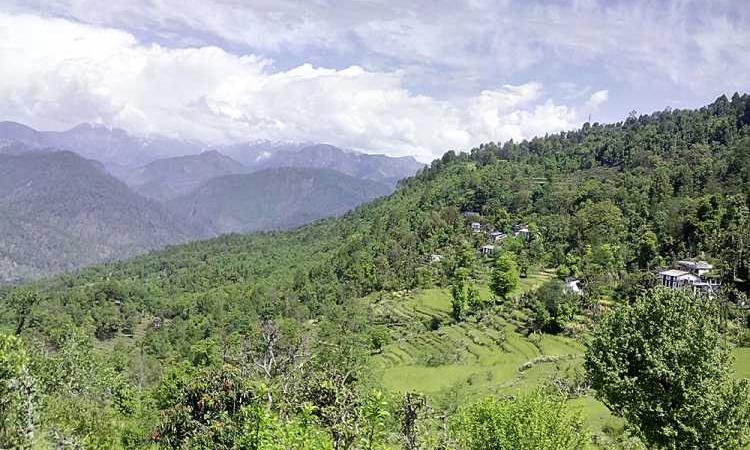
Forests are a primary source of food, water, medicine, fruits, shelter, bedding materials, fuel, fodder, and appliances for agriculture in rural areas, globally. The ‘sacred natural forest sites’ in the Himalayan mountains are a common center of different cultures, social groups, traditions, and beliefs.
A survey ‘Socio-administrative conservation and collection practices of the sacred Thal Kedar forest, Uttarakhand’ was conducted to understand the phytodiversity of the sacred Thal Kedar forest of Uttarakhand. The study area is located in Pithoragarh district. It is a Quercus leucotrichophora and Rhododendron arboretum rich type sacred forest.
The sacred Thal Kedar forest (1497-2602 metres above mean sea level) is a traditionally conserved forest guarded by a group of surrounding villages through their own set of rules, in the form of taboos, religious sanctions, and belief systems. The sacred forest is spread over 195 ha, dedicated to Lord Shiva and local deities, therefore, not exploited for the sake of livelihood, and is undisturbed. The area has scattered terrace cultivated land at the bottom of the sacred forest with human settlements, where different plant species are in use for day-to-day activities. There are about 15 villages with 869 households in the surroundings of the Thal Kedar Sacred Natural Site (TKSNS).
These villagers are judiciously using the forest resources as per the requirement and by following the set rules including a total ban on green felling, transportation, and trade, except with the permission of the District Forest Officer. These moral-based set rules have maintained the distinctive cultural identities, livelihood styles, integrity, and health of the indigenous people and the forest ecosystem on which they depend.
This paper by Joshi et al aims to widely popularize the wisdom to conserve associated with the sacred Thal Kedar forest and utilize its herbal treasure as modern green medicines. Detailed investigation via group discussions, key informant interviews, observation of participants, and secondary data collection deciphers that the sacred forest plays a potential role in the food and health of the people, both at the local and regional levels.
Discussion
The present survey results reveal that the sacred Thal Kedar forest is a common sacred center for people of different cultures, traditions, and beliefs, and all respect the common traditional set of rules passed through generations orally. All the communities have a common system for the protection of animals and plants. This moral value-based local knowledge come from ancestors and is passed from era to era through stories, rituals, moral constraints, and customs. The folklore stories emphasize the relationship between the environment and human beings and help to decipher the value to protect biodiversity.
Because of the current changing livelihood avenues and material aspirations in urban life, a tendency to use unsustainable means of natural resources may degrade moral-based forest management. Modern forest management is based on scientific principles and is assisted by the police system to restore the ecosystem and biodiversity-based measures. The early stages of the scientific concept neglecting the indigenous contribution have failed and both indigenous contribution and scientific knowledge are equally important to promote the development of biodiversity conservation. The confined local knowledge may lead to adverse effects on wildlife, so scientific intervention is equally important.
The Himalayan mountainous forests are rich in wild edible fruit plants. There is a need for a change in moral-based utilization practice in view of localized plant species and their wide application in the healthcare sector, to fulfill the market demand. The collection of edible fruits from the sacred Thal Kedar by adopting community-based trade and profit-sharing patterns under local administration may develop into a sustainable employment form.
Medicinal plant marketing is a sustainable job for local people to enhance their income, but the increased market demand for herbals has created a much higher pressure on the wild medicinal flora of the sacred forests and groves.
There is a need to balance the increased forest tourism, and economic interests like hotels and parks on the barren land with due honour to socio-cultural perspectives, and government regulations.
There are many traditional conservation practices developed and followed by indigenous communities in different parts of the world for the protection of biodiversity, and sustainable utilization. The sacred forests and sacred groves help in maintaining a healthy ecosystem, protecting the ecosystem, conserving the flora and fauna, and preserving the culture.
Traditional ways of resource management are becoming non-functional due to the direct conflict between the ever-increasing human population and limited natural resources. The myths and beliefs of earlier days associated with the sacred forests and groves no longer enjoy the same status and privilege as they used to in the past.
The impact of global warming and raised temperature may shift different species to higher elevations. The impact of these climate change-induced phenomena is a future task for policymakers, and stakeholders to protect, and manage the sacred Thal Kedar forest.
The erosion of traditional healing procedures and practices due to modernization and anthropogenic pressures is to be checked by digital documentation of the knowledge, which may lead to new drug delivery modes for a particular body ailment. Modern conservational strategies for awareness of biodiversity protection and promotion of herbal healthcare tourism will benefit the sustainable economic development in the region.
The full paper can be accessed here
/articles/conservation-and-collection-practices-sacred-thal-kedar-forest-uttarakhand